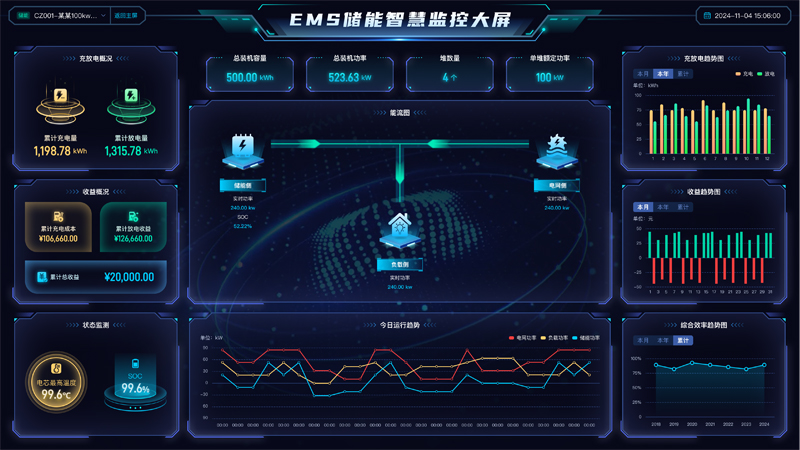Against the backdrop of the world's proactive response to climate change and promotion of sustainable development, energy transition has become an irreversible trend. However, with the rapid growth of the installed capacity of new energy sources such as photovoltaic and wind power, the intermittency and volatility of their power generation have brought severe challenges to the stable supply of energy. As a key factor in balancing the power generation and consumption of new energy, the market size of energy storage technology has witnessed explosive growth. In this process, the importance of energy management has become increasingly prominent. When developing and integrating traditional EMS energy management systems, a large amount of customized programming is involved, resulting in a long delivery cycle and making it difficult to respond promptly to market changes and project requirements. There are also numerous difficulties in operation and maintenance monitoring. Once a system failure occurs, troubleshooting and repair are time-consuming and laborious, seriously restricting the efficiency and effectiveness of energy management.
Against this backdrop, the Qualtech EMS energy Management system was born. As a new type of energy management system, it can achieve refined management at the station end and remote efficient centralized control. Q-EMS focuses on addressing the pain points of traditional EMS. Through innovative design and architecture optimization, it provides safer, smarter and more efficient management and control solutions for diverse scenarios such as power, large industries, bus stops, campuses, commercial buildings, and centralized control centers, as well as for energy storage power stations on the power generation side, state grid side, and user side, microgrid power stations, and new energy power stations.

The Qualtech EMS energy management system adopts a cloud-edge-device collaborative computing architecture. The cloud is mainly responsible for the distribution of model parameters, big data analysis and decision support. Edge computing services undertake complex logical operations and coordinate instruction distribution. The terminal equipment covers key components such as BMS, PCS, and liquid cooling, and is capable of precisely executing control instructions. The system supports the connection of multiple energy equipment such as photovoltaic, energy storage, diesel power generation, gas power generation, wind turbines, and charging piles, achieving unified management and control of energy equipment. At the same time, it is compatible with the interaction and connection of multiple systems such as the power grid dispatching management system and the virtual power plant operation management platform, effectively breaking down information silos.
At the functional level, this system integrates core functions such as SCADA, graph and model library integration, topology analysis, asset management, BMS and PCS monitoring and control, big data analysis, revenue calculation, electricity price management, and remote operation and maintenance. For different application scenarios, it can achieve multiple optimization operation goals such as reverse power control, load following, demand control, maximum photovoltaic consumption, peak shaving and valley filling, demand-side response, and carbon emission optimization. It also supports various operation control methods including centralized remote control, power balance, stable control, on-grid and off-grid switching, and black start. In addition, the intelligent operation and maintenance management module equipped in the system features monitoring of measurement point equipment, historical data analysis, and fault diagnosis and recovery functions. It can achieve one-stop operation and maintenance for EMS/BMS/PCS, effectively enhancing operation and maintenance efficiency.
In terms of technology, the Qualtech EMS system has significant highlights. On the one hand, the system supports both Linux and Windows operating systems and has good cross-platform compatibility. Its configuration design enables users to flexibly build monitoring screens, configure data models and generate reports through graphical operations without writing a large amount of code, significantly shortening the system development cycle and enhancing user autonomy and innovation capabilities. Meanwhile, features such as zero-code for device protocols, zero-code for process strategies, and zero-code for automatic website building enable the system to quickly adapt to the business processes and device configurations of different users. It has strong scalability and adaptability, lowering the threshold for user usage.
On the other hand, the Qualtech EMS system is deeply coordinated with the BMS. The combination of cloud and local BMS can predict in advance the risks of inconsistent battery SOC and thermal runaway. The local BMS independently controls the fan cooling of the battery box, and links the air conditioning and fire protection to ensure thermal balance and safety. Functions such as intelligent cell address allocation, intelligent high-voltage management, and intelligent balancing have enhanced the efficiency of production, debugging, and after-sales service. The health management system can identify battery cell risks in advance and support remote diagnosis and operation and maintenance. EMS efficiently calculates based on the high-frequency data from BMS and sends instructions to PCS, forming a stable triangular cooperative relationship. This breaks the compatibility issues of equipment from different manufacturers, reduces the failure rate, and enhances system reliability. The cloud platform monitors BMS information in real time. The edge server is equipped with an optional display screen to visually present the operation status of the battery system, improve diagnostic information and operation and maintenance prompts, and reduce the ability requirements for operation and maintenance personnel.
In the current context of accelerated energy transition and the continuous increase in the proportion of new energy, Qualtech's EMS energy management system, with its advanced architecture, diverse functions and technological advantages, provides an innovative solution for energy management. It has performed outstandingly in enhancing energy utilization efficiency, ensuring stable energy supply, and reducing operation and maintenance costs. It is expected to help various energy scenarios achieve efficient, intelligent and safe operation, and promote the transformation and upgrading of the energy industry towards a green and low-carbon direction, contributing to the construction of a sustainable energy system.